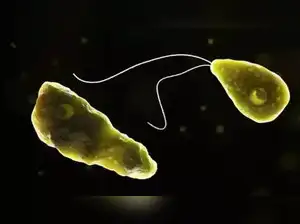In a deeply concerning development, a rare and deadly brain-eating amoeba has taken the life of a woman in Texas, raising alarm among health officials and communities alike. The-infection,-caused-by-Naegleria-fowleri,-is-exceedingly-rare-but-almost-always-fatal. As global temperatures rise and awareness remains limited, understanding this threat becomes more critical than ever.
Table of Contents
What is the Brain-Eating Amoeba?
Naegleria fowleri is a microscopic, single-celled organism commonly found in warm freshwater environments such as lakes, hot springs, and poorly maintained swimming pools. Despite its sensational nickname, the “brain-eating amoeba,” this organism doesn’t actively hunt brains—but when it enters the human body, the results can be devastating.
The amoeba enters through the nose, typically when someone is swimming, diving, or even rinsing their sinuses with untreated tap water. Once inside, it travels to the brain, causing a severe and often deadly condition called Primary Amoebic Meningoencephalitis (PAM).
Recent Case: Texas Woman Succumbs to PAM
According to health officials, the Texas woman was believed to have been infected while swimming in a freshwater lake. Symptoms started subtly—fever, headache, and nausea—but progressed rapidly into confusion, seizures, and coma. Despite medical intervention, she died within days.
This case marks another grim reminder of the amoeba’s lethality. According to the CDC, only four out of 157 known infected individuals in the U.S. from 1962 to 2022 have survived. The survival rate, therefore, is less than 3%.

How Does Infection Happen?
The amoeba does not cause illness if swallowed. Infection-occurs-only-when-water-containing-Naegleria-fowleri-enters-through-the-nose.-From-there,-the-amoeba-travels-to-the-brain-via-the-olfactory-nerve,-destroying-brain-tissue-as-it-goes.
Infections are most likely to occur:
- During the summer months, when freshwater is warmer.
- After diving or jumping into lakes or rivers.
- When using tap water for nasal irrigation (like with neti pots) without proper sterilization.
Symptoms of PAM (Primary Amoebic Meningoencephalitis)
Symptoms can start 1 to 12 days after exposure and usually lead to death within 5 days after symptoms begin.
Early symptoms include:
- Severe frontal headache
- Fever
- Nausea and vomiting
Later symptoms include:
- Stiff neck
- Confusion
- Lack of attention to people and surroundings
- Seizures
- Hallucinations
- Coma
Because these symptoms closely resemble bacterial meningitis, diagnosis is often delayed—which can be fatal.

Can It Be Treated?
PAM is difficult to treat. Antifungal and antibiotic medications, like amphotericin B, are typically administered intravenously and directly into the brain. Some patients have also been treated with miltefosine, a newer experimental drug.
Unfortunately, even with aggressive treatment, the survival rate remains low.
How to Stay Safe: Prevention Tips
Given the almost always fatal nature of the infection, prevention is key. Below is a helpful table with safety recommendations:
| Risk Situation | What to Do to Stay Safe |
|---|---|
| Swimming in warm freshwater | Avoid submerging your head; use nose clips; don’t disturb sediment |
| Using a neti pot or sinus rinse | Use only distilled, sterile, or boiled and cooled water |
| Entering hot springs or geothermal waters | Avoid putting your head underwater |
| After flooding or heavy rain | Avoid entering warm, stagnant floodwaters |
| Maintaining swimming pools | Keep pools properly chlorinated and disinfected |
Climate Change and Future Risks
With climate change leading to rising temperatures and warmer bodies of freshwater, the habitat for Naegleria fowleri is expanding northward in the United States. States that previously reported no cases are now beginning to see isolated infections.
This emphasizes the need for public awareness, especially in the face of extreme heatwaves and increased recreational water use.

Should You Panic? No. But Awareness Saves Lives
Although the infection is almost always fatal, it is also extremely rare. Millions-of-peopleswim-in-lakes-and-rivers-every-year-without-incident. The key lies in taking simple, precautionary measures to eliminate the risk.
There is no need to avoid outdoor fun during the summer, but being informed and cautious can make all the difference.
Final Thoughts
The tragic death of a woman in Texas due to a brain-eating amoeba reminds us of nature’s hidden dangers—but also of the importance of education and prevention. By understanding how the amoeba spreads and taking smart precautions, we can greatly reduce our risk of infection.
If you or someone you know experiences symptoms after freshwater exposure, especially during warm weather, seek medical attention immediately.
2 thoughts on “🧠 Deadly Brain-Eating Amoeba Claims Life of Texas Woman: What You Need to Know and How to Stay Safe 2025 best”